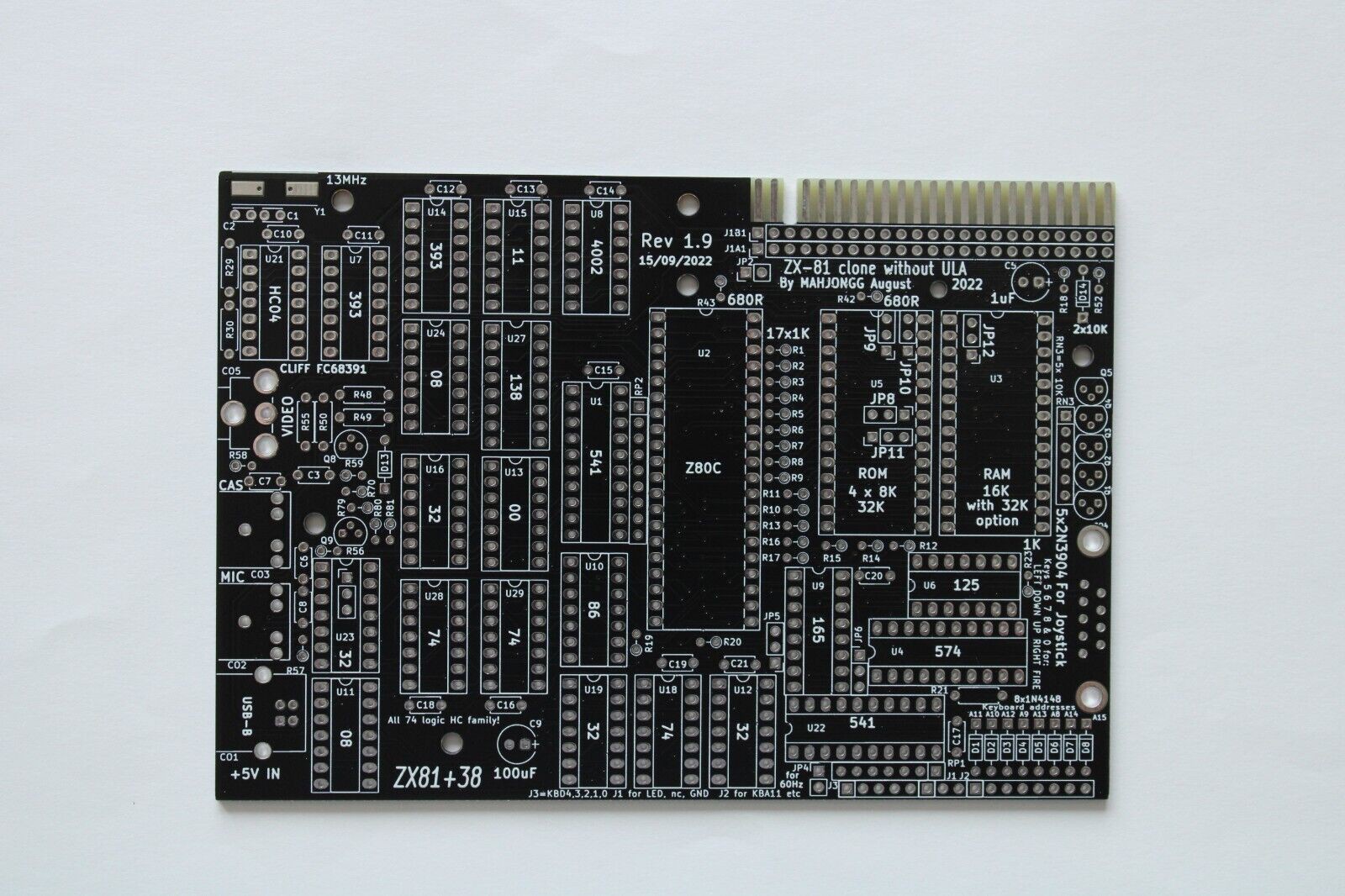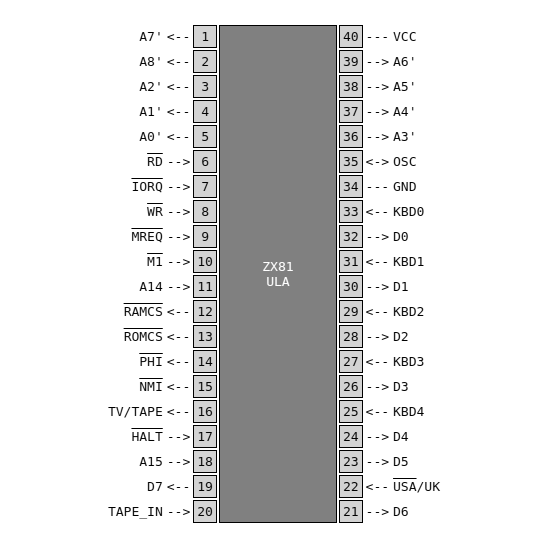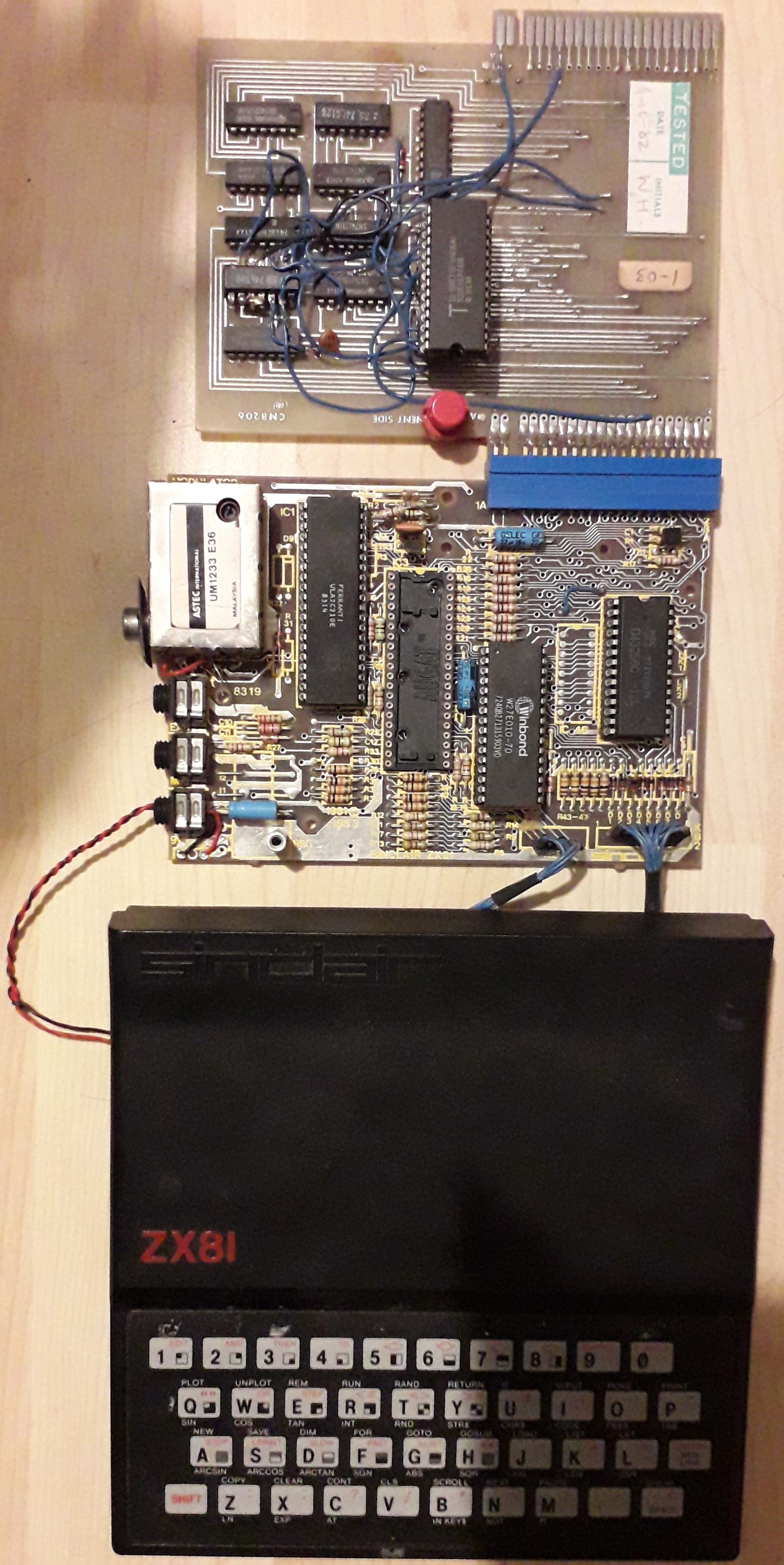-
PAL and TTL hybrid version
09/02/2023 at 18:06 • 0 comments2023-09-02
This is the approach I have decided upon.
- Use GAL chips to mop up the small-scale TTL logic
- Merge ZX81 and G007 logic together
- TTL chip for keyboard input buffer
- TTL chip for NOP driver
- TTL chip parallel-to-serial shift register (74HC165)
- 8K "Shoulders-of-Giants" ZX81 BASIC fixes some bugs and improves speed.
- 2K G007 firmware
- 2K ZX81 monitor
- 16K ROM containing all the firmware above
- 32K RAM expansion
- 1K,2K,8K or 32K RAM on ZX81 side
- GAL chip for memory decoder
- GAL chip for slow mode NMI generator, normal or square pixels
This has the following advantages
- Single ROM instead of BASIC plus graphics ROM.
- BASIC is pre-patched, so G007 patch at 3CXX is free.
- 4K G007 ROM space holds G007 and Monitor firmware, or a larger graphics ROM.
- CMOS static RAM can be battery backed.
The memory map should look like this:
/* RAM onboard: a a a a a a a a 1 1 1 1 1 1 5 4 3 2 1 0 9 8 00h,02h 0 0 0 0 0 0 x 0 ZX81 RAM patches at 00XXh and 02XXh 0x20 0 0 1 0 0 x x x G007 RAM (2k space) 0x30 0 0 1 1 0 x x x Spare RAM ROM unified: 0x0c 0 0 0 0 1 1 0 0 ZX81 ROM patch 0x28 0 0 1 0 1 x x x G007 ROM (2k space) 0x38 0 0 1 1 1 x x x Spare ROM RAM expansion: 0x40 0 1 0 x x x x x RAM expansion (8k) 0x40 0 1 x x x x x x RAM expansion (16k) 0x80 1 x x x x x x x RAM expansion (above 32k) Intermediate terms: */ RAM_patches = !a15 & !a14 & !a13 & !a12 & !a11 & !a10 & !a8 ; ROM_8k_at_0000h = !a15 & !a14 & !a13 ; RAM_2k_at_2000h = !a15 & !a14 & a13 & !a12 & !a11 ; ROM_2k_at_2800h = !a15 & !a14 & a13 & !a12 & a11 ; RAM_2k_at_3000h = !a15 & !a14 & a13 & a12 & !a11 ; ROM_2k_at_3800h = !a15 & !a14 & a13 & a12 & a11 ; /* The terms above simplify if you wish to minimise logic: */ RAM_at_2000h_and_3000h = !a15 & !a14 & a13 & !a11 ; ROM_at_2800h_and_3800h = !a15 & !a14 & a13 & a11 ; /* However I shall leave them unsimplified so they can be modified more easily: */ /* Drive pins: */ RAM_expansion = mreq & a15 // at 8000h, above 32 + mreq & a14 // at 4000h or C000h RAM_onboard = mreq & RAM_2k_at_2000h + mreq & RAM_2k_at_3000h; /* NB if onboard RAM is 8K or less, then RAM at 00XX and 02XX are aliased at 20XX and 22XX respectively. If you have more, then they are not, and the higher addresses are free for your use. */ ROM_unified = mreq & ROM_8k_at_0000h & !(RAM_patches) + mreq & ROM_2k_at_2800h + mreq & ROM_2k_at_3800h ; /* NB the logic above will probably expand to something like: */ ROM_unified_alt = + mreq & ROM_8k_at_0000h & a11 // 1000h + mreq & ROM_8k_at_0000h & a10 // 0800h, 1800h + mreq & ROM_8k_at_0000h & a8; // 0400h, 0600h, 1400h, 1600h /* So the memory address decoder uses 9 inputs and 3 outputs in: A15...8 !mreq out: ROM_unified RAM_onboard RAM_expansion That leaves 10 pins, up to 7 outputs and 3 inputs or 1 output and 9 inputs. */ memory_refresh = mreq & rfsh; /* clocks a D-type latch to set text or high-res mode */ pixel_latch = graphics_mode & mreq & cpu_clk ; pixel_output = graphics_mode & rfsh ; force_nop_2 = graphics_mode & m1 & A15 ; _rd = rd & a15 + rd & a14 + rd & something ; u9a_latch_d = mreq & _rd & force_nop_2 ; u9a_latch.d = u9a_latch_d; u9a_latch.ar = u9a_latch_d; d7 = _d7 ; d6 = _d6 ; d7.oe = _rd ; d6.oe = _rd ; _d7 = d7 ; _d6 = d6 ; _d7.oe = u9a_latch ; _d6.oe = u9a_latch ;I suspect the RAM patches may not need to be RAM, but I want to keep it working as near to the original for compatibility reasons.
2023-09-07
Spent a long time thinking.
I think I can get the memory decoder working in a way compatible with the G007 board.
Ian Bradbury's design uses an ATV750 which is like two 22V10 chips in one package, and each output macrocell can have its own clock and set/reset signals.
His logic makes much use of the latter, which is useful because the ZX80 circuit also has multiple clocks and set/reset signals. For that reason I am currently keeping the 74HC74 D-type latches.The HSYNC logic of the ATV750 will not fit in a 22V10, so I decided to use a 74HC393 counter and a 22V10.
At this point I wonder if I am actually saving much by using PAL chips, but I am saving many chips and even more if I integrate the pixel graphics board as well.
Andy Rea's ULA replacement design is interesting. There is no /RFSH signal to the ULA so obviously this has to be recreated inside. Andy uses a 3-bit counter that is reset by the /M1 signal and clocked by twice the CPU clock. We know when refresh occurs after /M1, and thus when to force a NOP instruction on the bus.
It seems there are several ways to implement the ZX81 logic.
2023-09-08
Had look at my genuine original ZX81 board to see why it was not working.
I printed out the circuit and went to work with a meter and highlighter pens.
I noticed that some of the data lines do not connect between the RAM and the ROM.Either my meter is faulty or many connections are faulty.
Have the solder joints started going dry from age?With this many faults, I'm considering buying a replacement because this will be cheaper in the value of my time.
Meanwhile, I shall set it aside and proceed with using the ZX80 board, which is at least running ZX81 BASIC.
I suspect I was in the middle of modding my boards to use a single ROM, and didn't leave it in a working condition.
2023-09-10
Installed WinCUPL on an old Intel i3 laptop. It is slow, but maybe upgrading it to an SSD might fix that. Right now, compiling small GAL chips is not a processor-intensive task.
I started it compiling logic so I shall be able to try some experiments soon.
-
ZX81 in programmable logic
08/28/2023 at 23:02 • 0 comments2023-08-28
I looked at Ian Bradbury's ZX81 in SPLDs, intending to mop up some of the small-scale-integration chips (2 to 4 input gates) that I don't have, into 22V10 logic chips that I do have. They're handy because they operate at 5V.
The logic is written in CUPL which is quite low level, like assembly language. Most designers have moved on to VHDL or Verilog, which are needed for today's big FPGA chips.
I thought I'd have a go compiling one of the ready-made designs.
There's a Cyclone II EP2C5 Mini Dev Board available dirt cheap and ZX81 code for it at https://www.qsl.net/yt2fsg/zx81/zx81_clone.html which I downloaded, unzipped and opened the project file from Quartus.
First of, it complains that my version of Quartus Lite, 20.1.1, will not compile for Cyclone II.
Okay, I told it to compile for Cyclone IV, which is the device on the DE-NANO that I have.Next it complained T80s not found. This Z80 model is someone else's project, so I guessed I need to get the latest version.
I went to https://github.com/mist-devel/T80 and downloaded the files as a zip file called T80-master.zip which needed unzipping into a sibling directory called T80. It unzipped into a directory called T80-master so that needed renaming. That fixed that issue.
Now it moans:
Warning (12019): Can't analyze file -- file ../FPGA_ZX8x_shared/*.vhd is missing
where *.vhd is many files. The whole directory is missing!
I eventually found this to be a better source of everything:
https://svn.mavipet.sk/svn/fpga_comps/HW_V1.0/
most of which are Cyclone II but FPGA_ZX81_Full does not get the Cyclone II error message.
But I still get other errors!2023-08-31
-
A ZX81 in TTL chips
08/21/2023 at 01:45 • 0 commentsOne can add slow mode hardware to a ZX80, but I decided to buy a board with this designed in already.
https://revspace.nl/Buiding_up_and_testing_the_ZX81%2B38_revision_1,9
https://github.com/mahjongg2/ZX81plus38
2023-08-19
I bought these boards on eBay.
The logic board has some nice features. The bus signals are available on a holes for a header, allowing the dreaded RAM-pack wobble to be avoided. The board can take up to 32K RAM, so you don't even need an external RAM pack.
Power is from a USB-B socket. I'll have to check the electric current budget.
On the down side, the clock is a crystal-and-inverter which mean I can't change frequencies by swapping an oscillator can. I think that can be hacked!
The on-board SLOW-mode generator will need hacking to run with a 14.7456 MHz clock. I'll design something that can be easily switched between two frequencies.
![]()
The keyboard is on a separate PCB, so no mechanical stress is transmitted to the motherboard. It has the key letters but not the associated keywords.
![]()
The boards are due in about a week, so I shall get hunting for components.
2023-08-21
Printed out the circuit diagram and parts list. I have:
- Z80 CPU
- ROM
- RAM
- HC165 shift register
- HC74 D-type latches
- HC04 inverters
- HC138 one-of-eight decoders
- ACT86 xor-gates
- ACT574 eight-bit edge-triggered latch
What I don't have:
- HC541 (but I could use some ACT245 with a bit of hacking)
- HC08
- HC32
- HC125
- HC393
- HC4002
I could use some PAL chips to mop up the random logic. I have plenty and they are easy to modify.
2023-08-23
Boards arrived. I have soldered the key switches to the keyboard.
The motherboard is very packed.
2023-08-25
I fitted 0603 surface mount resistors where there are vertical through-hole resistors.
The ACT574 and HC165 chip are now soldered to the board.
2023-08-31
I have no HC541 chips but plenty of HC245 chips. So I took two HC245 chips and bent pin 1 under the chip and wired it to VCC. I then fitted it to the HC541 sites.
2023-09-27
Fitted SIL sockets for keyboard.
2025-04-25
- Found HC08 and HC32 chips
2025-05-18
I decided to fit all the chips that were not completely used in the HSYNC and PORCH timing. This is basically all of them except U15 (a 74HC11) and U8 (a 74HC4002).
I plan to replace these with a GAL16V8, with more sophisticated timing, for both normal and square pixels.
The signals q7 down to q0 are on U14.
The asynchronous reset is on U15 pin 8.
The output signals PORCH and HSYNC are on pins 1 and 13 of U8 respectively.
So not a huge wiring job. Some pins can be piggybacked on the 74HCT393.2025-05-29
Shopping around for the last few bits for this project. I wondered why the Mouser 13 MHz crystal in the BOM did not appear in my search for crystals, and I spotted that the footprint is completely incompatible with the PCB. It has leads 2.5 mm apart, while the PCB has holes 4.88 mm apart. The PCB uses an HC49 footprint, not an HC46 footprint. So, the most suitable part seems to be IQD part LFXTAL031646B which is Mouser part 449-LFXTAL031646BULK. Also note that wire-ended crystals will need some insulation from the SMD footprint pads, otherwise the metal body will short-circuit them. See Mouser part 520-700-TFL-9001.
2025-11-11
Fitted R12,14,15, RP1, RP2, X1, original 2364 ROM.
2025-11-12
Applied 5V through USB cable, but failed to boot up. The current drain was exactly 100mA, which makes me wonder if it wanted more but was being limited to the USB peripheral limit. In another USB socket labelled 5V 2.1 A, it was 4.886 volts measured at the power input socket, 4.872 at ROM pin 24.
5V pins connected to each chip.
Sigh, I'm going to have to get out the scope and do a lot of hard work. :-(
-
A real ZX81
08/21/2023 at 00:30 • 0 commentsThis was the quickest way of getting a known-good reference machine.
Alas it is not very hackable, because most of the logic is inside the ULA.
![]()
It did come cased with a working membrane keyboard.
I extended the connections to the keyboard using extra-flex wire, allowing operation with the PCB accessible without removing the membrane from the case.
I hacked the ROM socket to accept a modern flash ROM, so that I could experiment with modified firmware.
I removed the 5V regulator and heatsink then wired a 2.1 mm power socket so that could be powered by a common 5V wall-wart power supply.
Attached is the G007 graphics board. I have tried to reduce the RAM-pack wobble by fitting a 32K RAM chip over the G007 ROM chip. D7 and D6 have to go to the edge connector. This should be an easy hack but for some reason it didn't work and I left that hack in that state. It still works with an external RAM pack if the 32K RAM is removed.
![]()
2023-09-15
Not working right now, I checked the ROM and RAM address lines. I tied the ROM /WE pin high. Seemed not to work but I had set my TV for white-on-black for my ZX80. Adjusting the controls allowed the ZX81 signal to be seen.
Still not working with the G007, or the DRAM pack, or both.
ZX80/ZX81 remakes
“Sinclair video generation is like a dog's walking on his hind legs. It is not done well; but you are surprised to find it done at all.”
 Keith
Keith


